

Butterflies have a very complicated
life. After people are born, they just get bigger. They start out life with arms,
legs, eyes, fingers, etc. and they keep these, usually, their entire life. Butterflies,
on the other hand, go through a number of very distinct changes during their life.
They change their appearance completely as they go from egg to caterpillar to pupa
to adult.
We are going to show you the "LIFE CYCLE" of a Monarch butterfly. Monarchs
are beautiful butterflies that travel through Florida in the spring and fall of each
year. They are common visitors to the Sealey Butterfly Garden. Remember that all
butterflies go through their own life story as eggs, caterpillars, pupa, and adult,
although they may look very different than the monarch.
|
|
|
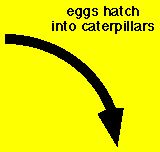 |
|
|
Monarch Life Cycle |
 |
 |
|
 |
SECOND, eggs turn into CATERPILLARS that feed on leaves. Caterpillars are really neat. They can be lot of different colors, shapes, a sizes. Sometimes, they have  spines or can
be very hairy and sometimes they even have horns or antenna. Monarchs have antenna
on both their front and back like this guy. Caterpillars are little eating machines,
eating and growing as fast as they can. As they get bigger, they go through several
changes of skin, called instars. When their skin gets too small, they just cut a
whole and climb out in their new, baggy but bigger skin. spines or can
be very hairy and sometimes they even have horns or antenna. Monarchs have antenna
on both their front and back like this guy. Caterpillars are little eating machines,
eating and growing as fast as they can. As they get bigger, they go through several
changes of skin, called instars. When their skin gets too small, they just cut a
whole and climb out in their new, baggy but bigger skin. What a caterpillar looks like can often tell you other things about its life. Let's look at some other kinds of caterpillars. Some caterpillars try to hide by being colored and shaped like leaves or stems. Others use spines and hair to keep predators 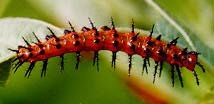 away like this Gulf Fritillary caterpillar. Gulf Fritillary
caterpillars mostly eat the leaves of Passion Flower plants, which contain some nasty
poisons. They aren't bothered by the poison, but keep some it in their body to discourage
birds from eating them. In fact, they taste so bad that they don't even hide! They
are bright orangish-red with blue stripes, as if to dare the birds to eat them.
Lots of the really bright colored caterpillars eat poisonous plants, keeping some
of the poison in their bodies so that birds will not want to eat them. They are bright
colored so that birds see them and remember that they are yucky to eat. away like this Gulf Fritillary caterpillar. Gulf Fritillary
caterpillars mostly eat the leaves of Passion Flower plants, which contain some nasty
poisons. They aren't bothered by the poison, but keep some it in their body to discourage
birds from eating them. In fact, they taste so bad that they don't even hide! They
are bright orangish-red with blue stripes, as if to dare the birds to eat them.
Lots of the really bright colored caterpillars eat poisonous plants, keeping some
of the poison in their bodies so that birds will not want to eat them. They are bright
colored so that birds see them and remember that they are yucky to eat. Then there are some really clever caterpillars that try to look like yucky-tasting caterpillars but that  are really quite tasty to a bird.Still other caterpillars
have eyespots or horns that they try to use to distract predators. Both of these
handsome fellows were found in the Sealey Garden. The scary guy with the big eyes
will become a are really quite tasty to a bird.Still other caterpillars
have eyespots or horns that they try to use to distract predators. Both of these
handsome fellows were found in the Sealey Garden. The scary guy with the big eyes
will become a 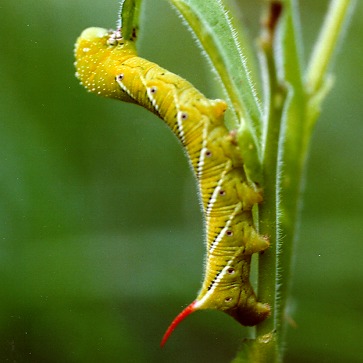 Spicebush Swallowtail and rears up to scare you off with his fake eyes
when he is bothered. Spicebush Swallowtail and rears up to scare you off with his fake eyes
when he is bothered. The fellow with the fearsome horn on the right is the Tobacco Hornworm, one of the largest caterpillars in the Sealey Garden. It lives on the tobacco plant and will eventually turn into a sphynx moth. Finally, one of the strangest caterpillars in the Sealey Garden is the Orange Dog caterpillar that grows up into a Giant Swallowtail. These are found only on the hops plant and they look just like a big pile of bird droppings! Rub one of these with your finger and you are in for a surprise. Not only will the caterpillar stick out a nasty red horn at you, but it will spray a nasty smell on your finger. |
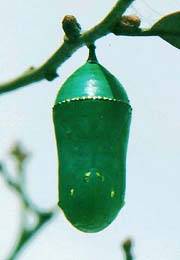 THIRD, when a caterpillar gets large enough or senses that it is the right time, it changes again. This time it creates its own little house, called a PUPA. This is a resting stage for the butterfly, where it is safe from the cold of winter and where it can spend its time changing into an adult. Pupae are constructed in many different ways. Most are fairly hidden, usually colored brown or green and attached to a sturdy stem. Some hang below branches and have beautiful markings of silver or gold like this monarch pupa; these are called CHRYSALISES. Moths frequently wrap themselves in silk or hair that they make themselves or even in leaves. These wrapped constructions are called COCOONS. Some pupa have no hard outer coating at all: sphynx moths simply bury themselves in the ground ,then go about their business of converting into an adult moth. |
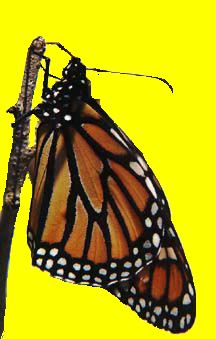 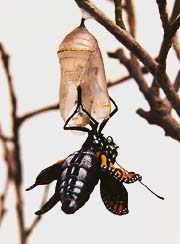 FOURTH
and finally, when it is time, the butterfly cuts his way out of the pupa and emerges
as an ADULT. His wings are usually shriveled and small, as on this monarch butterfly.After
emerging from the pupa, the butterfly will carefully and slowly flap its wings, which
helps it to pump blood into the veins of the wings and expand them to their full
size. After a few practice flaps and a brief rest, the butterfly is on his way in
the big world. As adults, most butterflies feed on nectar found in flowers. FOURTH
and finally, when it is time, the butterfly cuts his way out of the pupa and emerges
as an ADULT. His wings are usually shriveled and small, as on this monarch butterfly.After
emerging from the pupa, the butterfly will carefully and slowly flap its wings, which
helps it to pump blood into the veins of the wings and expand them to their full
size. After a few practice flaps and a brief rest, the butterfly is on his way in
the big world. As adults, most butterflies feed on nectar found in flowers.Eventually the butterflies will pair up, mate, and the females will produce eggs. And then they start this cycle all over again. |
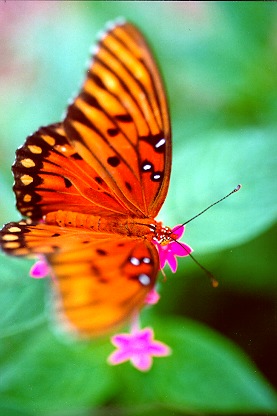 Remember
that butterflies and plants have a very close relationship that changes as the butterflies
pass through each stage of their life cycle. The adults are often very choosy as
to where they will lay their eggs. They want the eggs to stay safe and near food
the young caterpillars will eat. The caterpillars stay close to their food plant,
while avoiding predators such as assasin beetles, birds, and ants. The caterpillars
that take poisons from the plants they eat must stay on those plants for most of
their life. Remember
that butterflies and plants have a very close relationship that changes as the butterflies
pass through each stage of their life cycle. The adults are often very choosy as
to where they will lay their eggs. They want the eggs to stay safe and near food
the young caterpillars will eat. The caterpillars stay close to their food plant,
while avoiding predators such as assasin beetles, birds, and ants. The caterpillars
that take poisons from the plants they eat must stay on those plants for most of
their life. Finally, as adults, butterflies feed on nectar from flowers. Sometimes these are flowers from the same plants upon which they fed as caterpillars. In this case, they are "paying back" the plant by pollinating its flowers and helping it to produce seeds. In other cases, the butterfly adults visit a variety of other plants.Butterflies have very long tongues that allow them to such nectar out from deep within flowers. Here is a Gulf Fritillary feeding on flowers in the Sealey Garden. Next time you see a butterfly, remember that it has already spent much of its life as an egg, caterpillar or pupa. And, remember that it depends on plants for both its leaves to eat (as a caterpillar) and its flowers for nectar (as an adult). |
For questions or comments
about this page, e-mail us at: jackandanna@yahoo.com